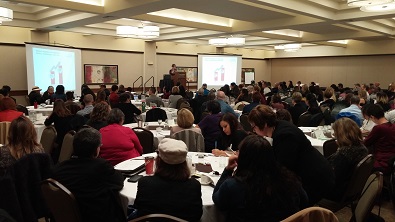People gather at the Sharing the Wisdom Conference on HIV/AIDS rates in the province. Photo by Joel Willick
The Government of Saskatchewan is seeking community input in the development of a multi-year plan to reduce HIV and AIDS rates in the province.
Several hundred people gathered at a conference in Saskatoon on Tuesday from different agencies and organization. They were there to speak about the government’s multi-year plan to fight HIV and AIDS in the province. The conference is entitled “Sharing the Wisdom.”
“The benefit of this conference is to listen to the wisdom in the room, and I am very excited about the power of the dialogue,” says Denise Werker, the province’s Chief Medical Officer.
The conference comes after recent reports have shown the HIV rates in the province are nearly double the national average. Statistics also show the numbers are increasing and 81 per cent of newly diagnosed patients self-identify as Aboriginal.
Amidst these troubling stats, Werker says it is vitally important to engage the community in this plan to fight the virus.
“Community engagement is absolutely critical,” she says. “We need to be patient centered and we know a person functions in their community, so we need the involvement of the community to help develop the plan that works best for them.”
Recently, some physicians in the province asked for the government to input a state of emergency over the HIV rates. Werker continued to assert that the province does not have the jurisdiction to input a state of emergency under the Public Health Act.
For Mary Ermine, a mother who has lived with HIV for the past seven years, the conference couldn’t be more welcome.
“It is very encouraging,” she says. “It gives me hope for people who live with HIV and people who are at high-risk.”
“I hope to see that people will take HIV as a problem and that is not something we can put on the back burner anymore,” says Ermine.
According to the province, the multi-year plan will be built on four pillars; community engagement, prevention and harm reduction, clinical management and surveillance and research.
